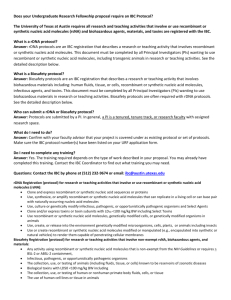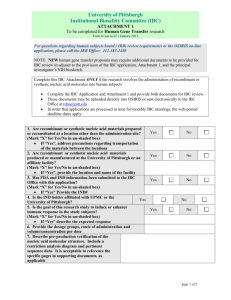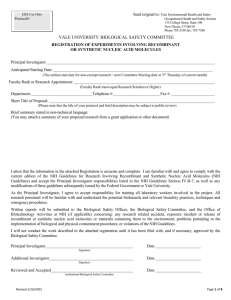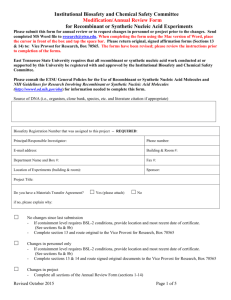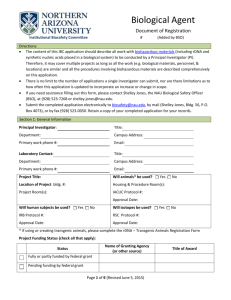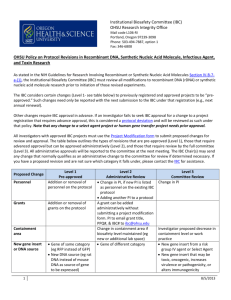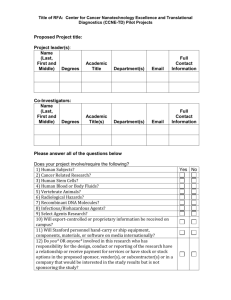NAU IBC Registration Form
advertisement
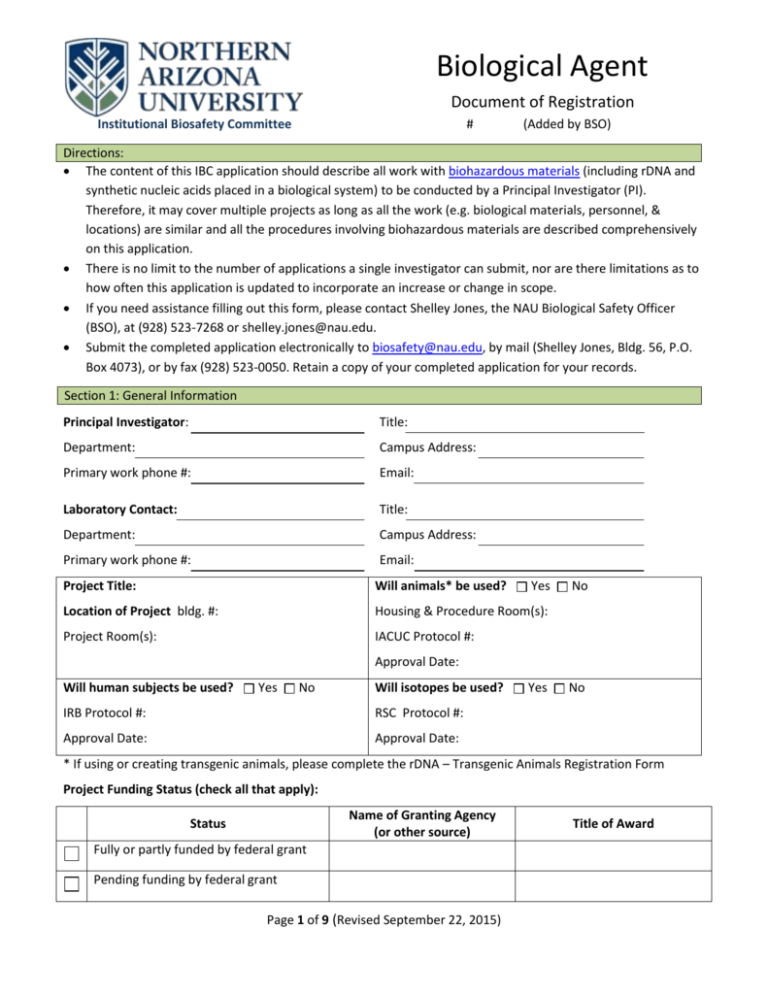
Biological Agent
Document of Registration
Institutional Biosafety Committee
#
(Added by BSO)
Directions:
The content of this IBC application should describe all work with biohazardous materials (including rDNA and
synthetic nucleic acids placed in a biological system) to be conducted by a Principal Investigator (PI).
Therefore, it may cover multiple projects as long as all the work (e.g. biological materials, personnel, &
locations) are similar and all the procedures involving biohazardous materials are described comprehensively
on this application.
There is no limit to the number of applications a single investigator can submit, nor are there limitations as to
how often this application is updated to incorporate an increase or change in scope.
If you need assistance filling out this form, please contact Shelley Jones, the NAU Biological Safety Officer
(BSO), at (928) 523-7268 or shelley.jones@nau.edu.
Submit the completed application electronically to biosafety@nau.edu, by mail (Shelley Jones, Bldg. 56, P.O.
Box 4073), or by fax (928) 523-0050. Retain a copy of your completed application for your records.
Section 1: General Information
Principal Investigator:
Title:
Department:
Campus Address:
Primary work phone #:
Email:
Laboratory Contact:
Title:
Department:
Campus Address:
Primary work phone #:
Email:
Project Title:
Will animals* be used?
Yes
Location of Project bldg. #:
Housing & Procedure Room(s):
Project Room(s):
IACUC Protocol #:
No
Approval Date:
Will human subjects be used?
Yes
No
Will isotopes be used?
IRB Protocol #:
RSC Protocol #:
Approval Date:
Approval Date:
Yes
No
* If using or creating transgenic animals, please complete the rDNA – Transgenic Animals Registration Form
Project Funding Status (check all that apply):
Name of Granting Agency
(or other source)
Status
Fully or partly funded by federal grant
Pending funding by federal grant
Page 1 of 9 (Revised September 22, 2015)
Title of Award
Funding to be provided by NAU
Funding provided by other organization
Section 2: Biological Agents
List each agent and the biosafety level/risk category associated with it.
Agent (genus, species, & common name {if applicable})
Biosafety level/Risk category
Section 3: Description of Project
Provide a brief description and overview of your research goals and objectives involving biohazardous agents,
recombinant DNA (rDNA), and/or synthetic nucleic acids placed in a biological system. This should be the general area
under study, not the detailed experimental methods; however, sufficient information must be presented so that the
IBC may understand the general scope of the work. Research descriptions should be readily comprehensible by a layperson and free from technical jargon (unless unavoidable; then briefly define/describe the term). Try to include:
overall objectives; the source(s) of biological material, describe host(s) and vector(s) to be used. If research involves
rDNA: what is the nature of the inserted DNA sequences (genetic modification); will a deliberate attempt by made to
express a foreign gene; indicate the protein or transcript that will be produced.
Section 4: Scope of Research
1. A) Will you transport or ship biological agents/infectious substances/diagnostic specimens?
Yes
No
B) Have you and your staff taken a Shipping & Transport of Biohazardous Materials class in the last 2 years?
Yes
No If yes, please provide the class date:
2. *If you answer ‘yes’ to any question below, please fill out a Health Hazard Assessment for the agent(s), the
Biological Safety Office is available for assistance*
A) Will you manipulate a naturally occurring pathogen(s), one that has not been altered by rDNA, which is
infectious to humans, animals, or plants?
Yes
No
B) Will you work with non-human primate body fluids, tissues, or cell cultures?
Yes
No
C) Will you work with human body fluids, human tissues, and/or human cell cultures?
Yes
No If yes, please describe:
If yes, have the researchers been registered in the bloodborne pathogen program?
Yes
No
If yes, please provide the names of personnel:
Page 2 of 9 (Revised September 22, 2015)
3. Will you acquire, store, generate, or manipulate animal (other than human and non-human primate) cells
and/or tissue samples?
Yes
No
4. Will you acquire, store, generate, or manipulate any regulated agents, select agents, and/or biotoxins?
Yes
No
5. Permits and Licenses:
A) If your project will involve a human pathogen or human material that originated outside of the USA,
a CDC Etiologic Agent Import Permit may be required. Please visit their website for information.
B) If your project uses infectious agents of livestock and biological materials containing animal material, a
USDA/APHIS permit may be required. Visit their website or call (301) 734-7834 for information.
C) U.S. Fish and Wildlife Service permits are required for certain live animals, including bats. Visit their website
or call 1-800-344-WILD for more information.
D) If your project will involve the import of select agents and toxins, you must be registered with CDC’s Select
Agent Program. Contact the NAU BSO, Shelley Jones, for more information.
E) If your project will involve the export of a wide variety of etiologic agents of human, plant, and animal
diseases, a license from the Department of Commerce may be required. Visit their website or call (202)
482-4811 for more information.
F) If the appropriate permit(s) have already been obtained, please list the applicable permit numbers:
Section 5: Biosafety Considerations & Procedures
Biosafety cabinet:
Yes
No
Model:
Location:
Certification date:
Personal protective equipment used (list):
Autoclave available: Yes
Location:
QA/QC monitored by:
No
Method of inactivation of agent(s):
Are Standard Operating Procedures (SOPs) prepared for
work with the agent(s)? Yes No
Disinfection of surfaces procedure:
Hand washing sink available?
How do you dispose of biohazardous waste?
Yes
No
1. Will you work with biological agents with/in any of the following aerosol-producing devices/procedures?
Centrifuges
Vortexers
Shakers
Sonicators
Tissue homogenizers
Infected animal necropsy
Intranasal inoculation
Pressurized vessels
Large volumes (≥ 10L)
of animals
(besides autoclaves)
of infectious material
Flow Cytometer
2. Have staff received immunizations and/or tests for agents in use or that are potentially present in the lab (e.g.
hepatitis B vaccine, Vaccinia vaccine, TB skin testing)?
Yes
No If yes, please list:
Page 3 of 9 (Revised September 22, 2015)
3. Will the protocols require the use of sharps, such as, but not limited to, needles, scalpels, and/or razor
blades?
Yes
No If yes, please visit the EH&S website to learn more about the NAU Needlestick Safety and
Prevention Program, then complete the evaluation form(s) as necessary.
Section 6: NIH Regulated Recombinant DNA and Synthetic Nucleic Acids Molecules Research
The NIH guidelines define recombinant and synthetic nucleic acids as:
i.
Molecules that are constructed by joining nucleic acid molecules and can replicate in a living cell (i.e.
recombinant nucleic acids);
ii.
Nucleic acid molecules that are chemically or by other means synthesized or amplified, including those
that are chemically or otherwise modified but can base pair with naturally occurring nucleic acids (i.e.
synthetic nucleic acids).
iii.
Molecules that result from the replication of those described in (i) or (ii) above.
A) My research does not involve rDNA or synthetic nucleic acids placed in a biological system.
If checked, proceed to Section 7
B) My research does involve rDNA or synthetic nucleic acids placed in a biological system. (This includes
plasmids, viral vectors, creation of transgenic organisms, gene therapy, etc.)
If checked, complete the rest of Section 6
Please select the classification for each type of recombinant/synthetic nucleic acid research performed in your
laboratory below. Use the EH&S online NIH Guidelines rDNA Training and/or the NIH Guidelines for Research
Involving Recombinant or Synthetic Nucleic Acid Molecules to help classify your research.
Section III-A-1-a: The deliberate transfer of a drug resistance trait to microorganisms that are not known to
acquire the trait naturally (see Section V-B, Footnotes and References of Sections I-IV), if such acquisition could
compromise the ability to control disease agents in humans, veterinary medicine, or agriculture, will be
reviewed by the RAC. (Requires IBC approval, RAC review, and NIH Director approval before research may
begin).
Section III-B-1: Experiments involving the cloning of toxin molecules with LD50 of less than 100 ng/kg of body
weight (Requires NIH/OBA and IBC approval before research may begin).
Section III-C-1: Experiments involving the deliberate transfer of recombinant or synthetic nucleic acid
molecules, or DNA or RNA derived from recombinant or synthetic nucleic acid molecules, into one or more
human research participants (Requires IBC and RAC review before research may begin).
Section III-D-1: Experiments using Risk Group 2, Risk Group 3, Risk Group 4, or restricted agents as host-vector
systems. Please select risk group below:
Risk Group 2 (RG2): Agents are associated with human disease which is rarely serious and for which
preventative or therapeutic interventions are often available.
Risk Group 3 (RG3): Agents are associated with serious or lethal human disease for which preventative or
therapeutic interventions may be available.
Section III-D-2: Experiments in which DNA from Risk Group 2, Risk Group 3, or restricted agents is cloned into
nonpathogenic prokaryotic or lower eukaryotic host-vector systems. Please select risk group below:
Risk Group 2 (RG2): Agents are associated with human disease which is rarely serious and for which
preventative or therapeutic interventions are often available.
Risk Group 3 (RG3): Agents are associated with serious or lethal human disease for which preventative or
therapeutic interventions may be available.
Page 4 of 9 (Revised September 22, 2015)
Section III-D-3: Experiments involving the use of infectious DNA or RNA viruses or defective DNA or RNA
viruses in the presence of helper virus in tissue culture systems.
Risk Group 2 (RG2): Agents are associated with human disease which is rarely serious and for which
preventative or therapeutic interventions are often available.
Risk Group 3 (RG3): Agents are associated with serious or lethal human disease for which preventative or
therapeutic interventions may be available.
Section III-D-4: Experiments involving whole animals that cannot be done at BSL-1
Section III-D-5: Experiments involving whole plants; Experiments to genetically engineer plants by
recombinant or synthetic nucleic acid molecule methods, to use such plants for other experimental purposes
(e.g. response to stress), to propagate such plants, or to use plants together with microorganisms or insects
containing recombinant or synthetic nucleic acid molecules that cannot be done at BSL-1.
Section III-D-6: Experiments involving more than 10 liters of culture.
Section III-D-7: Experiments involving Influenza viruses.
Section III-E-1: Experiments involving the formation of recombinant or synthetic nucleic acid molecules
containing no more than 2/3 of the genome of any eukaryotic virus (BSL-1 experiments only).
Section III-E-2: Experiments involving recombinant DNA-modified whole plants, and /or experiments involving
recombinant or synthetic nucleic acid molecule-modified organisms associated with whole plants, except
those that fall under Section III-A, III-B, III-D, or III-F (BSL-1 experiments only).
Section III-E-3: Experiments involving transgenic rodents modified by the stable introduction of recombinant
or synthetic nucleic acid molecules into their genome, or nucleic acids derived therefrom, into the germ-line
(transgenic rodents). (BSL-1 experiments only).
NIH Exempt Experiments (subject to review by the IBC Chair and Biological Safety Officer):
Section III-F-1: Experiments using synthetic nucleic acids that: (1) can neither replicate nor generate nucleic
acids that can replicate in any living cell, (2) are not designed to integrate into DNA, and (3 do not produce a
toxin that is lethal for vertebrates at an LD50 of <100 ng/kg.
Section III-F-2: Recombinant/synthetic molecules are not in organisms, cells, or viruses, and that have not
been modified or manipulated to make cellular membrane penetration possible.
Section III-F-3: Recombinant/synthetic molecules that consist entirely of the exact recombinant or synthetic
nucleic acid sequence from a single source that exists in nature.
Section III-F-4: Recombinant/synthetic molecules that consist entirely of DNA from a prokaryotic host
including its indigenous plasmids, or viruses when propagated only in that host (or closely related strain of the
same species), or when transferred to another host by well-established physiological means.
Section III-F-5: Recombinant/synthetic molecules that consist entirely of DNA from an eukaryotic host
including its chloroplasts, mitochondria, or plasmids (but excluding viruses) when propagated only in that host
(or a closely related strain of the same species).
Section III-F-6: Those that consist entirely of DNA segments form different species that exchange DNA by
known physiological processes, though one or more of the segments may be a synthetic equivalent. A list of
such exchangers is prepared and periodically revised by the NIH Director and can be found in the NIH
Guidelines for Research Involving Recombinant or Synthetic Nucleic Acid Molecules.
Section III-F-7: Those genomic DNA molecules that have acquired a transposable element, provided the
transposable element does not contain any recombinant and/or synthetic DNA.
Section III-F-8: Those exemptions as determined by the NIH Director to not present a significant risk to health
or the environment are listed in the appendices below. Please check all categories that apply:
Appendix C-I: Recombinant or synthetic nucleic acid molecules in tissue culture.
Appendix C-II: Escherichia coli K-12 host-vector systems.
Page 5 of 9 (Revised September 22, 2015)
Appendix C-III: Saccharomyces host-vector systems.
Appendix C-IV: Kluyveromyces host-vector systems.
Appendix C-V: Bacillus subtilis or Bacillus licheniformis host-vector systems.
Appendix C-VI: Extrachromosomal elements of gram positive organisms.
Appendix C-VII: The purchase or transfer of transgenic rodents.
Appendix C-VIII: Generation of BL1 transgenic rodents via breeding.
Recombinant or Synthetic Nucleic Acid Molecules Project Summary
1. Does this research involve “the deliberate
transfer of a drug resistance trait to
microorganisms if such acquisition could
compromise the ability to treat or manage
disease agents in human and veterinary
medicine, or agriculture?” Yes
No
If yes, explain:
3. Are you increasing the pathogenicity of a
pathogen?
Yes
No
If yes, explain:
5. Are you working with genetic material
coding for a vertebrate toxin as defined in
the NIH Guidelines?
Yes
No
If yes, explain:
2. Will the research involve the use of antibiotic selection
markers?
Yes
No
If yes, list the markers and the microbial agents used
(e.g., kanamycin resistance marker in E. coli).
4. Will you be working with >10 liters of recombinant
material?
Yes
No
If yes, explain:
6. List all cell lines to be used in the research,
including the source species (Note that work with
human or primate cell lines requires BSL2
containment.):
7. Purpose of the project (one sentence):
8. Project goals/intent:
9. Expected outcome:
10. What will be analyzed or measured?
11. What effect would transgene expression have in an accidental host?
12. What are possible safety hazards associated with the recombinant/synthetic nucleic acid molecules
component of this project, and how will you address them?
13. Use the table below to detail recombinant or synthetic nucleic acid molecules used in this project. Please use
one column per construct, using additional sheets as necessary. Additionally, please attach vector/construct
maps (electronic versions are preferred, e.g. .bmp, .tif, .jpg, .pdf, but hard copies are acceptable)
Construct 1
Construct 2
Construct 3
Construct 4
DNA/Gene
Source
Gene Function
Selectable
Marker
Construct 5
Example
Green
fluorescent
protein
(GFP)
marker
Antibiotic
resistance
gene
Vector Name
(provide maps)
pTR-UF12
Vector Type/
Origin
Viral/
Adenoassociated
virus (AAV)
Page 6 of 9 (Revised September 22, 2015)
Expression
control
elements
(promoter,
enhancer,
regulatory
elements, etc)
MCMV
enhancer,
Chicken Bactin
promoter
1x 108 to
1x1012
infectious
particles/ml
E. coli, Sure™,
Mouse heart
cells, in vivo
Conc / titer of
rDNA (i.p./ml)
Host & Strain
Host Range
(including any
genetic
alterations to
host range)
Is recombinant
or synthetic
DNA made in
your lab? If
not, where?
What (approx.)
% of original
vector genome
has been
deleted or
substituted?
Human,
other
mammalian
cells
UF Powell
Gene
Therapy
Center
2/3
Section 7: Dual Use Research of Concern (DURC)
1. Does your research involve one or more of the agents or toxins listed below?
Yes
No
Avain influenza virus (highly pathogenic)
Francisella tularensis
Bacillus anthracis
Marburg virus
Botulinum neurotoxin
Toxin-producing straings of Clostridium
Burkholderia mallei
botulinum
Burkholderia pseudomallei
Variola major virus
Ebola virus
Variola minor virus
Foot-and-mouth disease virus
Yersinia pestis
2. Please indicate whether your research project produces, aims to produce, or can be reasonably anticipated to
produce any of the following experimental effects. The IRE should review descriptions of the research in
question, the PI’s assessment of the applicability of the categories of experiments, and other relevant
information, as warranted. Examples of materials to consider include the project proposal, any project reports,
any outcomes of previous reviews for dual use, and examples of similar research in the literature.
Enhances the harmful consequences of the agent or toxin
Yes
No
Disrupts immunity or the effectiveness of an immunization against the agent or toxin withour clinical
or agricultural justification
Yes
No
Confers to the agent or toxin resistance to clinically or agriculturally useful prophylactic or therapeutic
interventions against that agent or toxin or facilitates their ability to evade detection methodologies
Yes
No
Page 7 of 9 (Revised September 22, 2015)
Increases the stability, transmissibility, or the ability to disseminate the agen or toxin
Yes
No
Alters the host range or tropism of the agent or toxin
Yes
No
Enhances the susceptibility of a host population to the agent or toxin
Yes
No
Generates or reconstitutes an eradicated or extinct agent or toxin listed above in Question 1
Yes
No
3. If you checked yes for any of the experimental effects listed in Question 2, please provide more information:
Section 8: Personnel
Identify all personnel that will be involved in the project described above. By signing, they agree that they are familiar
with and agree to abide by the current NAU and federal guidelines.
Name
NIH
Biosafety
BBP
CITI
Signature
Date
Guideline
and/or
Hepatitis B Responsible
Signed
s rDNA
Bloodborne Vaccination
Conduct of
Training/
Pathogens
Status
Research
Quiz
Training/Quiz
(Circle
Training/Quiz
Date
Date
One)
Date
Declination
form or
vaccinated
Declination
form or
vaccinated
Declination
form or
vaccinated
Declination
form or
vaccinated
Section 9: Principal Investigator’s Acknowledgement of Responsibilities
By signing below, I certify that I have read the following statements and agree that I and all listed personnel on my IBC
protocol (including all personnel added to the protocol in the future) will abide by the statements, as well as all
policies and procedures governing the use of infectious agents, recombinant DNA, and other biohazardous materials,
as outlined by NAU policies and applicable federal regulations. I recognize that:
I have a responsibility for ensuring the information provided in this application is complete, accurate, and
thorough by participating in the development of the IBC application and conducting a review of the
protocols.
I have read and understand my responsibilities as Principal Investigator outlined in Section IV-B-7 of the NIH
Guidelines and agree to comply with these responsibilities.
I have responsibilities for ensuring that anyone who enters my laboratory practices appropriate biosafety
precautions.
I have responsibilities for ensuring that all listed participants conducting this work have received or will
receive appropriate training in safe laboratory practices and procedures for this protocol before any work
begins on this project. Also, I have a responsibility for ensuring that anyone working in or having access to
spaces where this project is conducted must be instructed on the hazards associated with this project. The
IBC or EHS staff may review my records documenting the training or instruction of personnel.
Page 8 of 9 (Revised September 22, 2015)
I have a responsibility for complying with the requirements pertaining to the shipment and transfer of
biohazardous materials.
I have a responsibility for reporting to the Biosafety Officer immediately any spill of biohazardous material,
and containment equipment of facility failure, any permitted decontamination of equipment, and/or any
breakdown in procedures, which may result in potential exposure of laboratory personnel and/or the public
to the biohazardous material.
I have a responsibility for reporting to the Biosafety Officer immediately should an employee become ill
and/or exhibit symptoms and signs consistent with an infection caused by an organism associated with my
research.
I have a responsibility for following all the applicable guidelines as approved for this protocol.
I have a responsibility for submitting in writing a request for approval from the IBC of any significant
modifications to the protocol.
I must not carry out the work described in this application until it has been approved by the IBC.
I attest that this application is accurate and complete.
Electronic Signature of the
Principle Investigator:
Date:
By typing your name you are submitting an electronic signature that confirms your understanding and adherence to
the above statements and IBC policies. This is considered legal documentation and confirmation of your agreement to
execute all activities as approved.
Page 9 of 9 (Revised September 22, 2015)
